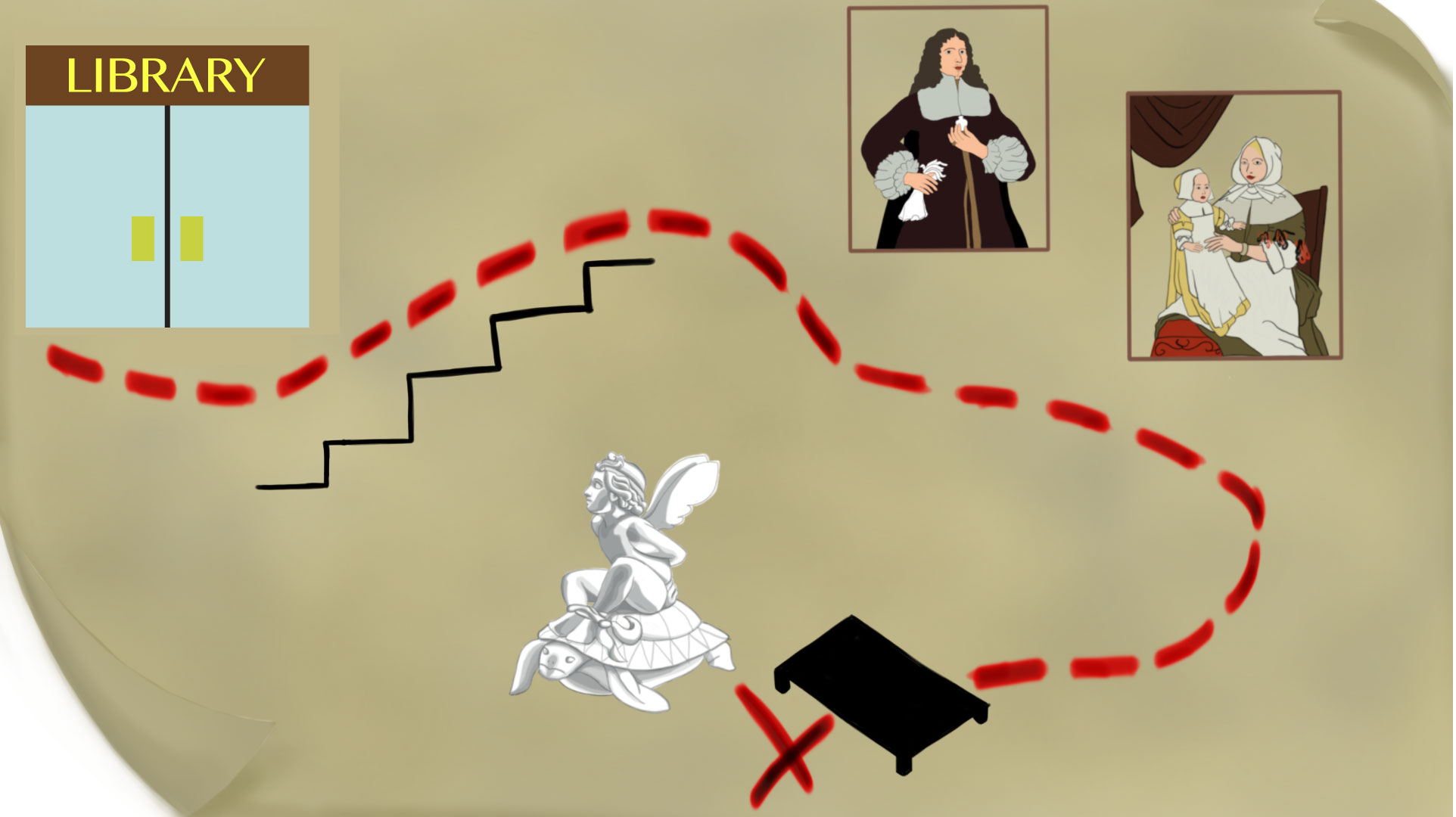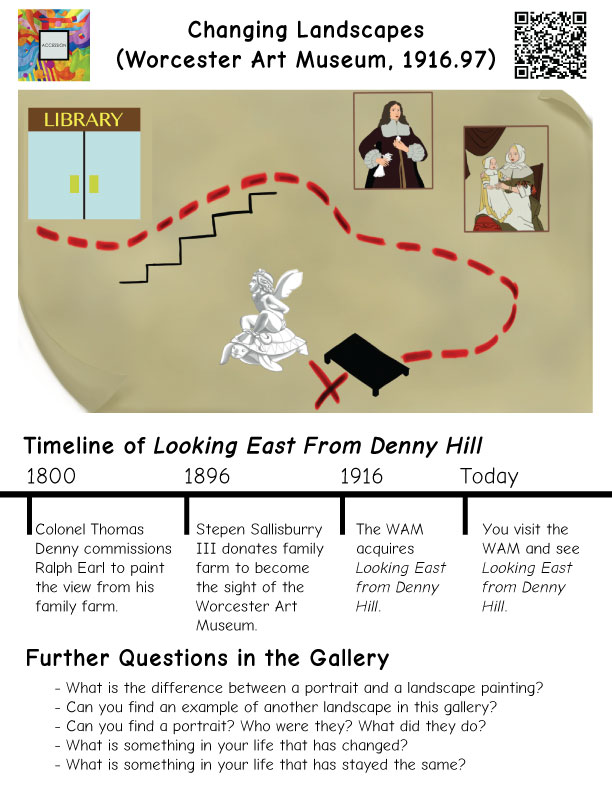9: Changing Landscapes
In this special episode of Accession for Kids, we take a look at a landscape painting of a place that may be familiar, even if it doesn't look the same today.
Map to Looking East from Denny Hill:
Map to Looking East from Denny Hill made by V Silverman.
Audio for Poem Without Music:
Welcome to Accession, friend,
Today I’ll be your guide,
Go to the Worcester Art Museum,
and make your way inside.
Now this is the kind of story,
for the young and young at heart,
But no matter how young you are,
remember not to touch the art.
Now there’s a map that you can follow
Drawn by my friend V,
It starts the path, to the painting we want
outside the library.
Head up the stairs, and through the doors
and towards Mr. & Mrs Freak,
(And little baby Mary,
whose quite rosey in the cheeks.)
Then to your right we’ll see a bench
where we will take a seat,
Besides a cupid on a turtle,
bound at his hands and feet.
Now just like cupid you will want
to sit absolutely still,
as I tell you about the piece before you,
“Looking East from Denny Hill.”
Now way back in 1916,
over one hundred years ago,
Before the days of Netflix and YouTube,
and even tv shows,
this painting was the ninety-seventh piece,
acquired by the museum.
But like most of the pieces here,
Folks then weren’t first to see ‘em.
For this painting was painted in 1800,
more than one hundred years before,
When Colonel Thomas Denny,
(yes the Denny the hill is named for)
He had worked, had served, had suppressed some rebellion,
Had got the things to be gotten,
And decided to move from the family farm,
to sell books, textiles, and cotton.
But Thomas didn’t want to lose
his families scenic view,
And this was before we had cameras,
he couldn’t just snap a pic or two.
So he wrote to his friend, Ralph Earl, a painter,
and said “I’ve got a job for you,
I know you normally paint portraits,
And you’re good at what you do!
But in the backgrounds, you tend to add scenery
that makes them feel more true.
Now I’m moving soon and I want to take
these green hills and skies of blue,
I need this landscape painted,
is that something you could do?”
Now Ralph had traveled all over,
from England to New York to New Haven,
He knew of that little piece of home
that Thomas would soon be craven’.
And so in lush greens hues,
and warm golds and blues,
Ralph captured all the luster,
Of the villages, you can see,
from the hill called Denny,
namely Shrewsbury and Worcester.
“But that’s not Worcester,” you might think,
and it isn’t our Worcester yet,
There’s no Clark, or Holy Cross, or WPI,
or a Telegram and Gazette,
It’s hard to imagine that this was it,
Just two hundred years ago,
But just like you and me
A city takes some time to grow.
For example in 1896,
in this wide landscape somewhere,
There’s a tract of land by those two churches
Just beyond that hill right there-
And that land was owned
By one Mr. Stephen Sallisbury the Third,
Who decided Worcester needed some culture,
And so that piece of land he conferred
To a project to build an institution
A place for art from far and near
Like a winking statue from fifty centuries ago,
Or a landscape that was painted right here.
Yes, somewhere in this painting,
Is the place that will eventually be
The Worcester Art Museum,
Where this painting can be seen.
So this landscape captures two things,
Both Thomas Denny’s prided view,
And the city that’s on the verge of growing up,
When Worcester was brand new.
Now there's a lesson in this
But its nothing we should fear
It's just that things will often change
From year to year to year,
Sometimes change seems good
And sometimes it seems bad
But its nothing that we should run from
Nothing to make us feel sad
In the grand scheme of things
The world tends to go up
You might even say life is like
A half filled up cup.
Things are changing all around us
Things are changing every day
You might change your clothes,
Or decide to wear your hair a different way.
We have to accept change because
it happens no matter what,
If things don’t change, we don’t get better,
We end up in a rut.
But not everything changes
There are things that stay the same
Like that you are always you,
Or this picture in this frame.
Even when we accept change
We don’t leave behind the old part,
You can keep it, you can love it,
You can hold it close to your heart.
And with that lesson,
our story today
is coming to its end
I hope you liked it,
I hope you learned something,
Have a good day at the museum, friend.
Sources:
Information on Looking East from Denny Hill came from the Worcester Art Museum's Timeline of Early American Paintings and information on the history of the Worcester Art Museum came from the website of the Worcester Art Museum.
Music:
Blue Jay from Feathers by Blue Dot Sessions
Paper Napkin from The Contessa by Blue Dot Sessions
One Little Triumph from Piano Mover by Blue Dot Sessions
Noodle Opus from Piano Mover by Blue Dot Sessions
Special Thanks:
My special thanks this week goes out to my Mom, who has always supported my love of everything, who bought me books when I got good grades, made sure we got to the National Gallery's of Art in DC when we went there, and traveled halfway around the world with me so I could see the Parthenon, the Acropolis Museum, and the ruins in Olympia. Even this last week, she helped me arrange a special backstage tour of the Denver Art Museum. She works harder than anybody I know and has never stopped believing in me or my crazy ideas. So thank's Mom!
Credits:
Our theme music was performed by Mike Harmon, with recording, editing, and mixing from Casey Dawson. Our show art was made by V Silverman. The script is turned into a transcript by Amanda Borglund. Social media and marketing assistance comes from Lauren LaPorto. This episode was produced, written, recorded, and edited by T.H. Ponders .




